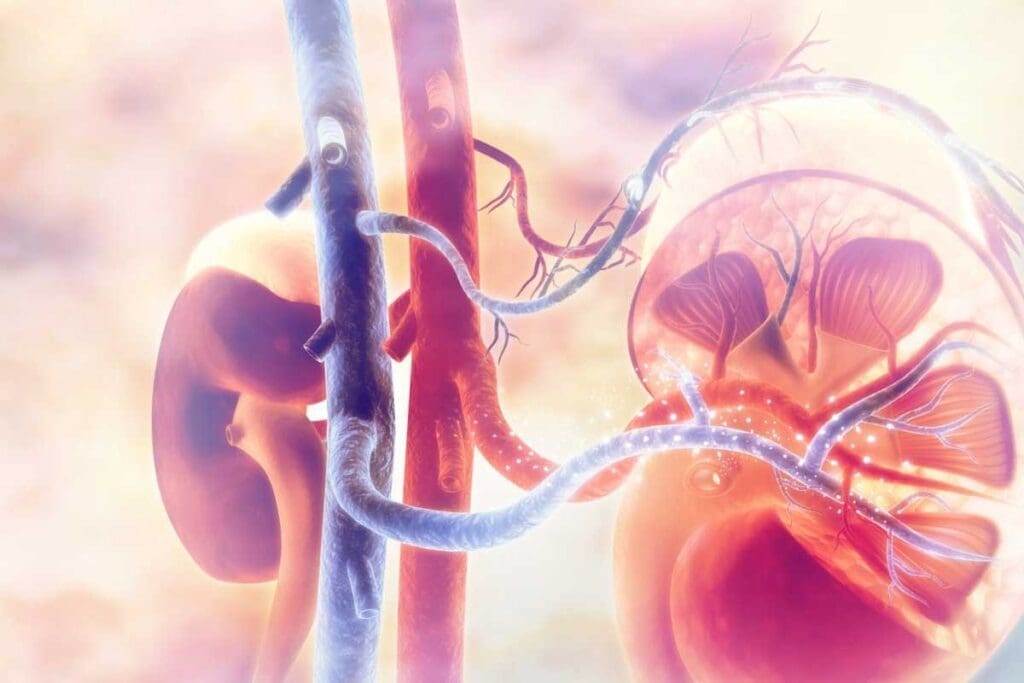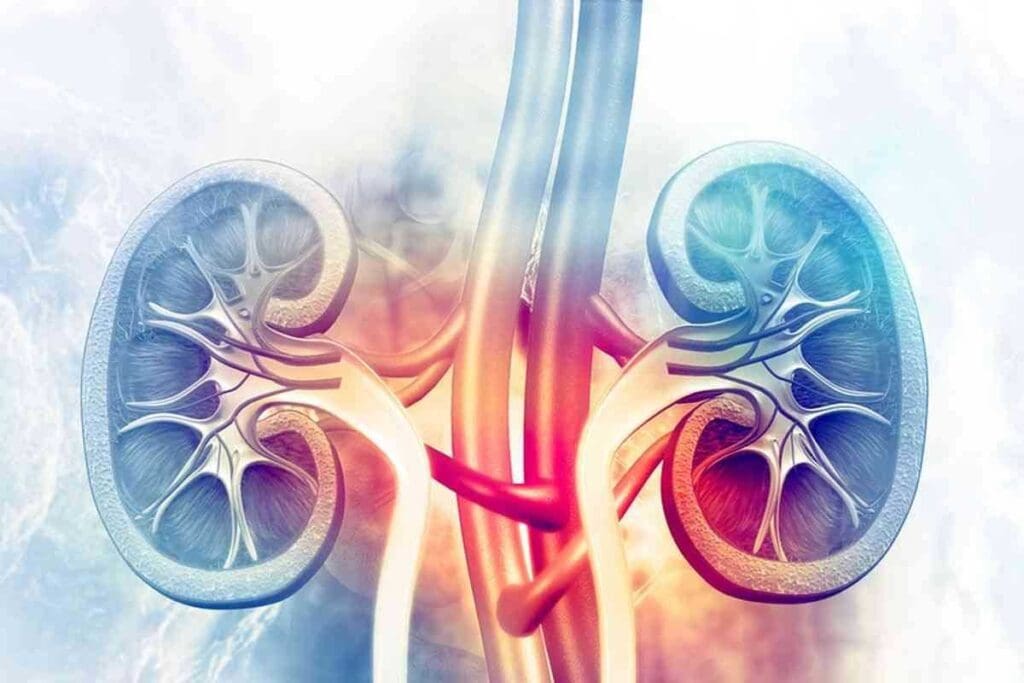Last Updated on November 27, 2025 by Bilal Hasdemir
Learn about mag 3 renal scan, results analysis, Lasix use, and how this test helps diagnose kidney function problems. At LivHospital, we use advanced tools to check how well your kidneys work. A MAG3 renal scan is a special test that looks at how well your kidneys are working. It uses a tiny amount of a special tracer to do this.

This test is great for finding out if there’s a blockage in your kidneys. It helps tell if the blockage is real or if it’s just a sign of how your kidneys are working. Knowing the results of a MAG3 scan helps doctors and patients decide the best treatment.
Key Takeaways
- Understand the role of MAG3 renal scans in diagnosing kidney issues.
- Learn how renography helps assess kidney function and anatomy.
- Discover the benefits of using Lasix-enhanced nuclear imaging.
- Find out how to interpret renogram results.
- Explore the importance of accurate diagnosis in treatment planning.
1. What Is a MAG3 Renal Scan and How It Measures Kidney Function
A MAG3 renal scan is a detailed test for kidney function. It’s key for checking how the kidneys work and spotting any urine flow problems.
We use technetium-99m mercaptoacetyltriglycine (MAG3) in this scan. MAG3 is secreted mainly by the proximal renal tubules. This makes it great for checking kidney function and urine flow.
The Science Behind Technetium-99m Mercaptoacetyltriglycine
Technetium-99m mercaptoacetyltriglycine is a compound that binds to technetium-99m. This isotope is used a lot in nuclear medicine. When injected, MAG3 is mostly taken by the kidneys and then goes into the urine. This lets us see the kidneys and urinary tract in detail.
MAG3 in renal scans has many benefits. It gives clear images of the kidneys and checks their function well. A leading nuclear medicine expert says,
“MAG3 is very useful in patients with kidney problems. It gives clearer images than other substances.”
Tracking Fluid Movement from Kidneys to Bladder
In a MAG3 renal scan, we watch how the substance moves from the kidneys to the bladder. We take pictures at different times to see urine flow and kidney function. The scan finds any blockages or problems in the urinary tract.
The pictures from the scan make time-activity curves. These curves show how the kidney works over time. They’re key for finding kidney issues and checking kidney health.

Knowing how MAG3 renal scans work helps us see their importance in kidney diagnosis and care. The info from these scans is very helpful for doctors to give the best care to patients with kidney problems.
2. Understanding Renography: The Complete Picture of Kidney Health
Renography is a detailed imaging method that shows how well the kidneys work. It gives us a full view of kidney health and function. This helps us understand how the kidneys perform and their structure.
Renogram and Kidney Scintigraphy Explained
A renogram shows how kidneys work over time, often through kidney scintigraphy. Kidney scintigraphy uses tiny amounts of radioactive materials to spot and track kidney diseases. It lets us see the kidneys’ shape and how they function, helping find problems.
The kidney scintigraphy process includes:
- Administering a radioactive tracer
- Using a gamma camera to image the kidneys
- Looking at the images to check kidney function
Looking at renograms and scintigraphy images helps us understand kidney performance. It also helps us spot any issues.

Time-Activity Curves and Their Clinical Significance
Time-activity curves are key in renography. They show how the radioactive tracer moves through the kidneys over time. These curves help us measure kidney function and find different kidney problems.
The importance of time-activity curves lies in their ability to:
- Check how well each kidney works
- Spot any blockages in the urinary tract
- See if treatments are working
By studying time-activity curves, we get important insights into kidney health. This helps us make better choices for patient care.
3. MAG3 vs. DTPA Scanning: Key Differences in Nuclear Medicine Tests
Two main nuclear medicine tests, MAG3 and DTPA scans, help check kidney function. They differ in how they work, making one better than the other for certain patients.
Why MAG3 Provides Clearer Images in Children
MAG3 scans are great for kids because they show the kidneys more clearly. This is because MAG3 is extracted more efficiently, showing the renal tubules better. Kids’ kidneys are smaller and more complex, so MAG3 is a big help.
The lower background activity of MAG3 also helps in getting clearer images. This makes it easier to spot and track kidney problems in young patients.
Benefits of DTPA for Measuring Glomerular Filtration Rate
DTPA scans are better for checking the glomerular filtration rate (GFR). GFR shows how well the kidneys are working. DTPA is mainly filtered by the kidneys, making it perfect for GFR tests. This is key for patients with chronic kidney disease.
- DTPA scans directly measure GFR.
- They help check kidney function in various diseases.
- They guide treatment plans.
In summary, MAG3 and DTPA scans both have their uses in nuclear medicine. The right choice depends on the patient’s needs. Knowing the strengths of each helps doctors pick the best test for their patients.
4. The Role of Lasix in Renal Scans: Diuretic Renography Explained
In renal scans, Lasix helps tell true blockages from just swelling. This method is key for checking how well the kidneys work and spotting blockages in the urinary tract.
How Diuretics Help Differentiate True Obstruction from Functional Dilatation
Diuretic renography uses Lasix to see how kidneys handle more urine. It’s important for spotting real blockages versus just swelling. True obstruction means urine can’t flow well, while functional dilatation means the tract is swollen but not blocked.
Lasix shows how kidneys handle more urine. If there’s a real blockage, urine flow slows down. But if it’s just swelling, urine flows better.
Optimal Timing and Protocol for Lasix Administration
When and how to give Lasix is very important for good results. Lasix is given 15-20 minutes after a special dye is injected. This lets us see how kidneys react to more urine.
- The standard dose of Lasix is 1 mg/kg in children and 40 mg in adults.
- It is administered intravenously to ensure rapid action.
- Dynamic imaging continues after Lasix administration to capture the kidney’s response.
By sticking to this plan, we can find and measure urinary tract blockages. This helps doctors decide the best treatment.
5. Normal Renal Scan with Lasix Results: Patterns of Healthy Kidneys
Understanding normal renal scan results with Lasix means looking at quick tracer removal and normal flow. These signs show that kidneys are working well.
During a renal scan with Lasix, we check for certain signs of healthy kidneys. We focus on rapid tracer clearance and normal drainage patterns.
Rapid Tracer Clearance: What It Means
Rapid tracer clearance means the kidneys quickly get rid of the radioactive tracer. In a normal scan, the tracer leaves the kidneys and pelvicalyceal system fast. This shows the kidneys are doing their job.
The diuretic effect of Lasix helps with this quick removal. It boosts urine production. This helps tell if there’s a blockage or if the kidneys are just swollen.
- Efficient removal of the tracer from the kidneys
- Quick transit of the tracer through the renal pelvis
- Normal kidney function is indicated by the rate of clearance
Interpreting Normal Drainage Patterns
Normal drainage in a renal scan with Lasix means the tracer flows smoothly from the kidneys to the bladder. Healthy kidneys let the tracer move freely without any blockages.
We look at the time-activity curves from the scan to check drainage. These curves tell us how well the kidneys drain the tracer. Normal drainage looks like:
- Smooth, rapid descent of the time-activity curve
- Minimal residual activity in the renal pelvis after Lasix administration
- Prompt drainage of the tracer into the bladder
In summary, a normal renal scan with Lasix shows clear signs of healthy kidneys. By looking at quick tracer removal and normal flow, doctors can spot and treat kidney issues accurately.
6. Abnormal Renal Scan with Lasix: Identifying Kidney Obstructions
An abnormal renal scan after Lasix can show kidney problems, like blockages. We check how well the kidney filters waste and reacts to Lasix during a MAG3 renal scan.
Delayed Washout Patterns and Their Clinical Significance
Delayed washout patterns on a renal scan with Lasix hint at kidney blockages. Normally, Lasix quickly clears the tracer from the kidney. But if there’s a blockage, this process is slow.
Delayed washout patterns mean we need to look deeper to find the cause and how bad it is. This info helps us decide the best treatment, like surgery or stenting, to fix the blockage and help the kidney work right again.
Grading Systems for Obstruction Severity
We use grading systems to measure how bad a kidney blockage is. The diuretic renography grading system is one way to do this. It looks at how fast the tracer leaves the kidney and how much stays.
- Mild obstruction: Some delay in washout, but eventual clearance
- Moderate obstruction: Noticeable delay in washout with significant tracer retention
- Severe obstruction: Little to no washout, indicating significant blockage
These systems help us better understand and treat kidney blockages. They help us plan the right treatment and check if it’s working.
In short, an abnormal renal scan with Lasix, showing delayed washout, is key to finding kidney blockages. Knowing what these signs mean and using grading systems helps us give better care to patients with kidney problems.
7. Renal Scan Results Interpretation: Diagnosing Kidney Conditions
Understanding renal scan results is key to spotting kidney problems. These results help us see how well the kidneys are working and find any issues. The MAG3 renal scan is special because it shows how well the kidneys function and how they drain.
Identifying Hydronephrosis Through MAG3 Renal Scan
Hydronephrosis is when the kidney’s pelvis and calyces get too big because of a blockage. MAG3 scans can spot this problem by showing where the radiotracer builds up. “MAG3 scans have changed how we diagnose hydronephrosis,” say nuclear medicine experts.
Signs of hydronephrosis on a MAG3 scan include:
- Dilated renal pelvis and calyces
- Delayed clearance of the radiotracer
- Asymmetric or absent function in severe cases
Detecting Renal Artery Stenosis
Renal artery stenosis is when the arteries to the kidneys become narrowed. This can hurt the kidneys a lot if not caught early. MAG3 scans can hint at this problem by showing less or slower uptake in one kidney. Early detection is key to avoiding lasting harm.
Renal scintigraphy, like MAG3 scans, helps find renal artery stenosis. It looks at how different the two kidneys are and how they react to captopril. This method is not as direct as angiography but gives useful information.
“Renal scintigraphy offers a safe way to check kidney function. It’s great for patients where other tests can’t be used or don’t work.”
By looking closely at renal scan results, doctors can find many kidney problems. Hydronephrosis and renal artery stenosis are just a few. The MAG3 renal scan is very important in figuring out these issues.
Conclusion: The Value of MAG3 Renal Scans in Modern Kidney Diagnostics
We’ve seen how MAG3 renal scans are key in checking kidney health and finding kidney problems. This scan is a top tool in kidney care, showing how kidneys work and look through special imaging.
Nuclear medicine scans, like the MAG3, give a full picture of kidney health. This helps doctors make better choices for their patients. These scans help us find and treat kidney issues better.
Getting results from MAG3 scans is vital for today’s kidney care. It helps spot problems early and start the right treatments. As nuclear medicine gets better, so will the role of these scans.
FAQ
What is a MAG3 renal scan, and how does it differ from other types of renal scans?
A MAG3 renal scan is a test that uses a special dye to check how well the kidneys work. It’s different because it gives clearer images, which is great for kids and people with kidney problems.
What is renography, and how does it provide a complete picture of kidney health?
Renography uses tests like MAG3 scans to check kidney function. It looks at how urine flows through the urinary tract. This gives a full view of kidney health by analyzing different parts of kidney function.
How does Lasix (furosemide) enhance the diagnostic value of renal scans?
Lasix helps in renal scans by making more urine. This helps find out if there’s a blockage or not. The right time and way to use Lasix is key for good results.
What are the characteristics of normal renal scan results when Lasix is used?
Normal results show the dye is quickly cleared and urine flows well. This means the kidneys are working right. There should be no blockages or dye left behind.
How do abnormal renal scan results with Lasix indicate kidney obstruction?
Abnormal results might show the dye takes longer to leave. This could mean there’s a blockage. Doctors can then decide the best treatment based on how bad the blockage is.
Can MAG3 scans diagnose specific kidney conditions like hydronephrosis and renal artery stenosis?
Yes, MAG3 scans can spot conditions like hydronephrosis and renal artery stenosis. By looking at the scan, doctors can see signs of these problems. This helps them treat the issues quickly and effectively.
What are the benefits of using MAG3 scans in pediatric patients?
MAG3 scans are good for kids because they give clear images with less radiation. This makes them a top choice for checking kidney function in children.
How do DTPA scans compare to MAG3 scans in assessing glomerular filtration rate?
DTPA scans are better for measuring kidney function, like the glomerular filtration rate (GFR). MAG3 scans are great for looking at kidney function and blockages, but DTPA scans are better for GFR.
What is the role of diuretic renography in evaluating kidney function?
Diuretic renography, with Lasix, is key to checking kidney function. It shows how well the kidneys respond to diuresis. This helps doctors tell if there’s a blockage or not, leading to better treatment.
How are renal scan results interpreted to diagnose kidney conditions?
Doctors look at how the dye is taken up and excreted, and how it changes with diuresis. This helps them find and treat problems like blockages, hydronephrosis, and renal artery stenosis.
References
- Taylor, A. T., Nally, J., Aurell, M., et al. (2018). SNMMI Procedure Standard / EANM Practice Guideline for Diuretic Renal Scintigraphy in Adults With Suspected Upper Urinary Tract Obstruction. Seminars in Nuclear Medicine, 48(4), S1–S35. https://pmc.ncbi.nlm.nih.gov/articles/PMC6020824/
- Itoh, K. (2001). 99mTc-MAG3: Review of pharmacokinetics, clinical application to renal diseases and quantification of renal function. Annals of Nuclear Medicine, 15(3), 179–190. https://link.springer.com/article/10.1007/BF02987829
- Esteves, F. P., Fair, J. M., Soon, S., & Ziessman, H. A. (2006). Normal Values for MAG3 Clearance and Curve Parameters. American Journal of Roentgenology. https://www.ajronline.org/doi/full/10.2214/AJR.05.1550






